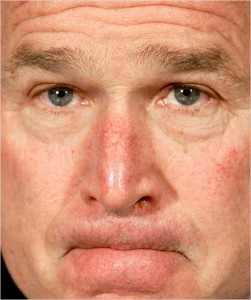Isolated Looks
2009 February 1
I swore to myself that I would not post another comment on George W. Bush and portraiture, but filmmaker Errol Morris’s recent lengthy online discussion with the editors of three major wire services about photographing the 43rd president was just too insightful and so redolent of some assumptions about photography as evidence to pass up. Morris asked Vincent Amalvy (Agence France-Presse), Santiago Lyon (Associated Press), and Jim Bourg (Reuters) to choose photographs from their respective agency archives that were representative of the Bush presidency. Their observations range from the questionable (such as Amalvy’s paean to American photographers’ unprecedented access to their leader, and Bourg’s view that “it wasn’t often that you saw George Bush become emotional and cry in the course of his presidencyâ€) to self-critically astute (such as Lyon’s thoughts about the “managed†and “orchestrated†nature of presidential photography). So the Morris forum is well worth reading—but also because the interchange reveals an oddly reverent attitude to the expressiveness of the “iconic†photograph. In conversation, Morris and his interlocutor create a narrative for each Bush photograph—but are these photographs really narratives? We know there is a larger narrative that each photograph is a part of (whether it’s September 11th, Hurricane Katrina, or the Iraq War), and we should be equally aware how the camera frame both focuses attention and eliminates information. It may be a very fine point, but I was struck by the participants’ overall failure to acknowledge the particular fiction created by the action of the camera shutter. In a fraction of a second, the camera “captures†an event, isolating it in an image removed from the “mobility†of history. Morris and company debate the meanings of certain Bush expressions (although it should be noted that Bourg is particularly uncomfortable about analyzing shots), and yet are these authentic expressions: is a momentary grimace, pop-eyed look, or flaring of nostrils an expression or, in the movement of seconds, a transition between expressions? Has the photographer captured an essential truth or a distortion created by accident? I’m not searching for an existential truth here but, rather, suggesting how precarious the meanings of still photography’s documentation can be.
Last 5 posts by Josh Brown
- The Civil War Draft Riots at 150 – A Public Event - June 17th, 2013
- Alfred F. Young - November 7th, 2012



